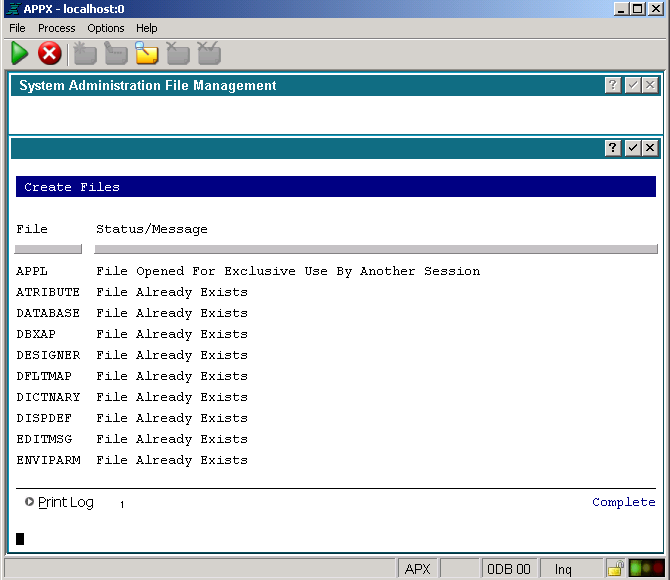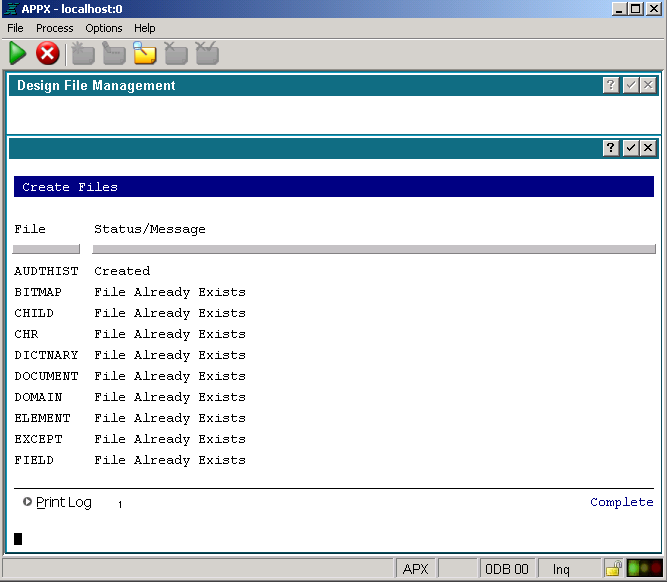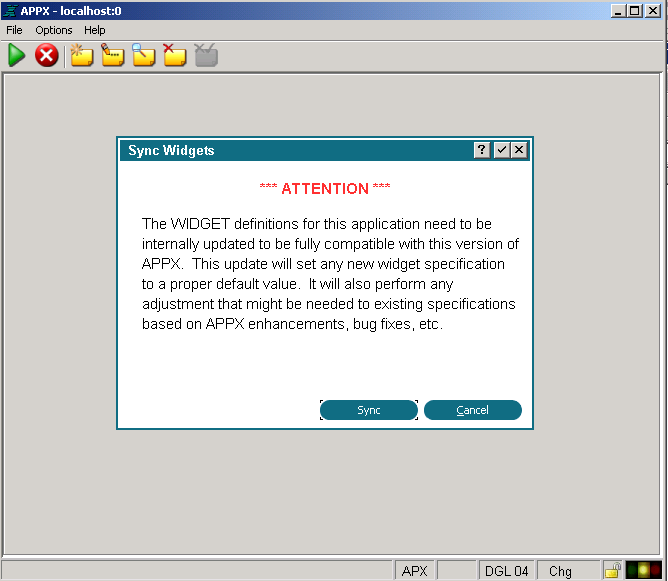APPX Windows- APPX 5 Upgrade Instructions
This page provides the information needed to upgrade an existing APPX 4.2.a Windows installation to APPX 5.Overview
Warning - These instructions specifically apply to upgrading from APPX 4.2.a to APPX 5. If you are upgrading from an older release of APPX you must upgrade to APPX 4.2.a first and then upgrade to APPX 5.
To upgrade your existing APPX Windows installation from APPX 4.2.a to APPX 5, you must complete the following steps:
- Complete the preliminary tasks
- Convert Your System Administration Files
- Install the APPX Utility upgrade
- Install a new APPX 5.0.0 License Key
- Configure the new APPX Login Manager
- Final Tasks
Preliminary Tasks
- Ask all users to log off
- Verify the integrity of all files in your system and correct any errors.
- System Administration Files
- System Administration (Option 3) > System Setup (Option 1) > System Administration File Management (Option 2) > Select All (Option 2) > END > Verify Files (Option 12) > Verify Integrity of APPXIO Files (Option 1) Should be on file system path similar to \Appx\data\0SA\Data\*
- Each file should have a status of OK, or Skipped: Temporary or Non-indexed File.
- System Administration (Option 3) > System Setup (Option 1) > System Administration File Management (Option 2) > Select All (Option 2) > END > Verify Files (Option 12) > Verify Integrity of APPXIO Files (Option 1) Should be on file system path similar to \Appx\data\0SA\Data\*
- Design Files
- System Administration (Option 3) > Database/Applications (Option 3) > Design File Management (Option 5) > Enter the Application and Version number for each application that you want upgraded to APPX 5 > Select all files > Verify Files (Option 12) > Verify Integrity of APPXIO Files (Option 1) Should be on a file system path similar to \Appx\data\00\TGL\Data\*. Look for failures. Skips are okay.
- Data Files
- System Administration (Option 3) > Database/Applications (Option 3) > File Maintenance - Database / Applications (Option 2) > Select the database (RETURN, RETURN) > For each application select Database Management (Option 5) > Select All (Option 2) > END > Verify Files Menu (Option 12) > Verify Integrity of APPXIO Files (Option 1. Look for failures. Skips are okay. Path will be similar to \Appx\data\TGL\TGL\Data\*
- System Administration Files
- Backup your system
- Obtain a new Release 5.0 License from your Reseller or Distributor
Convert Your System Administration Files
The first step of upgrading your APPX 4.2.a installation to APPX 5 is to convert your System Administration files to the new APPX 5 format. The System Administration files for APPX 4.2.a are not compatible with APPX 5 and must be converted to the APPX 5 format. Follow the directions below to convert your System Administration files.Install the Upgrade Application
Two different methods are provided to install the upgrade application on Windows. There is a GUI installer and a Console Mode (character mode) installer. Most sites will use the GUI Installer, the character mode installer is intended for sites using Windows Core Server (Windows without a GUI). The same installer is used for both methods. The installer will automatically detect if it is being run as a command or from a GUI Desktop, although in some cases you may have to add "-c" to the command line to force the character installer. Regardless of which installation method is used, the result is the same.GUI Installation
Log in to your system as an administrative user. Download and run the installer for the APPX 4.2.a to APPX 5 upgrade application Appx4to5upgrade-windows.exe from the APPX web site or the APPX ftp server. After a few moments, the APPX 4.2 to 5.0 Upgrade Application Setup Wizard should display the Welcome screen. Click on the "Next" button to continue.Character Mode Installation
If you don't have access to a GUI, you can run the this installer in character mode by appending "-c" to the command line. After a few moments, the Appx Setup Wizard should display the Welcome message. Press Enter to continue the installation.
C:\Appx>Appx4to5upgrade_windows -cUnpacking JRE ...
Preparing JRE ...
Starting Installer ...
This will install Appx 4.2 to 5.0 Upgrade Application on your computer.
OK [o, Enter], Cancel [c]
Next, the installation and conversion instructions will be displayed. Press Enter when you are ready to continue. Installation Instructions This conversion utility is an Appx application that will read your
existing 4.2 System Administration files and write new 5.0 System
Administration files into a work directory. Once Appx 5.0 is installed
you can copy the System Administration files from this work directory
into place as your live System Administration files.
Here are the steps involved in installing and using this utility
1. Install conversion application into your current appx installation path.
2. Add application 5SA version 00 in System Administration - Applications.
3. Add database 5SA connected to Application 5SA 00 in System Administration - Databases.
4. Process the Data Dictionary for application 5SA 00.
5. Create data files for Database 5SA, application 5SA.
6. Run application 5SA, database 5SA and follow the on screen instructions.
Choose the location for the installation. Where should Appx 4.2 to 5.0 Upgrade Application be installed?
[C:\Appx]
The files will then be copied to your hard disk. When this is finished, you are ready to continue with 'Configure the Upgrade Application'
Configure the Upgrade Application
After installing the Upgrade Application, you must run APPX as an APPX System Administrator and configure the Upgrade Application. Add the upgrade application (5SA 00) to the Applications file. System Administration (Option 3) > Database / Application (Option 3) > File Maintenance - Applications (Option 1)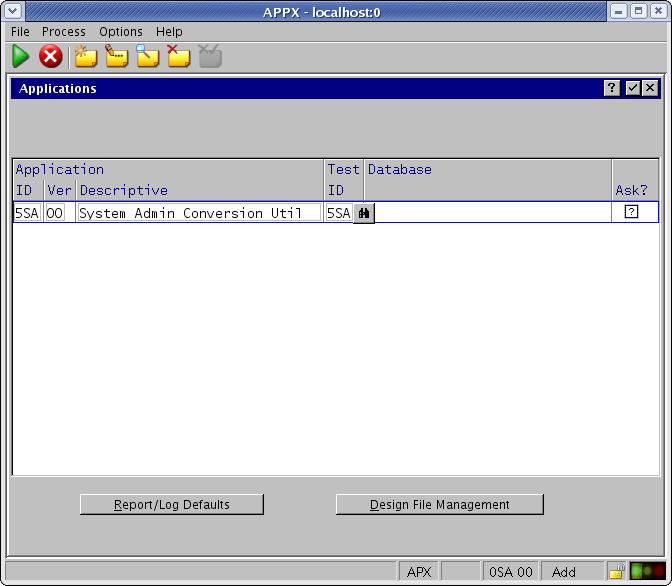 Create the Design Files for Application 5SA.
Create the Design Files for Application 5SA.
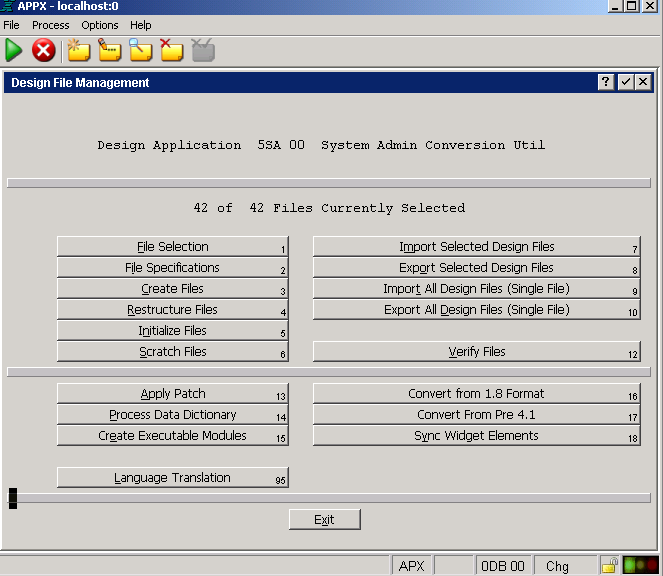 The Create Files menu selection above should report "File Already Exists" for each file as shown below. If not, the application was not installed in the correct location. Repeat the installation steps above, specifing the correct location
The Create Files menu selection above should report "File Already Exists" for each file as shown below. If not, the application was not installed in the correct location. Repeat the installation steps above, specifing the correct location
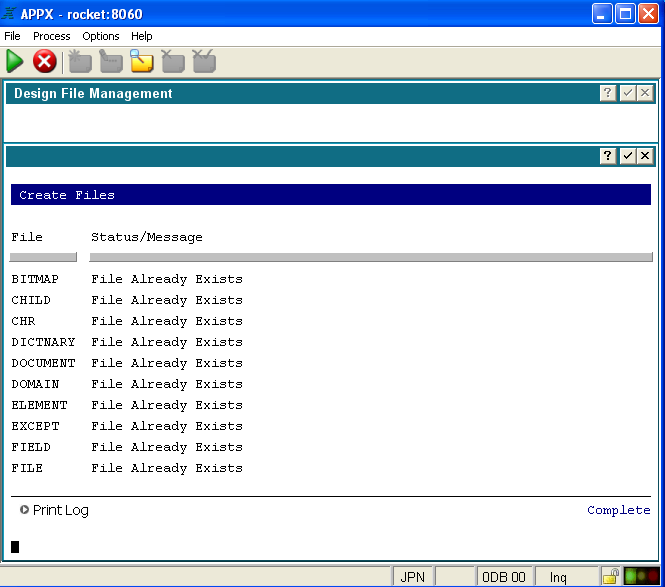 Add the database (5SA) for the Upgrade Application to the Databases file.
System Administration (Option 3) > Database / Application (Option 3) > File Maintenance - Databases / Applications (Option 2)
Add the database (5SA) for the Upgrade Application to the Databases file.
System Administration (Option 3) > Database / Application (Option 3) > File Maintenance - Databases / Applications (Option 2)
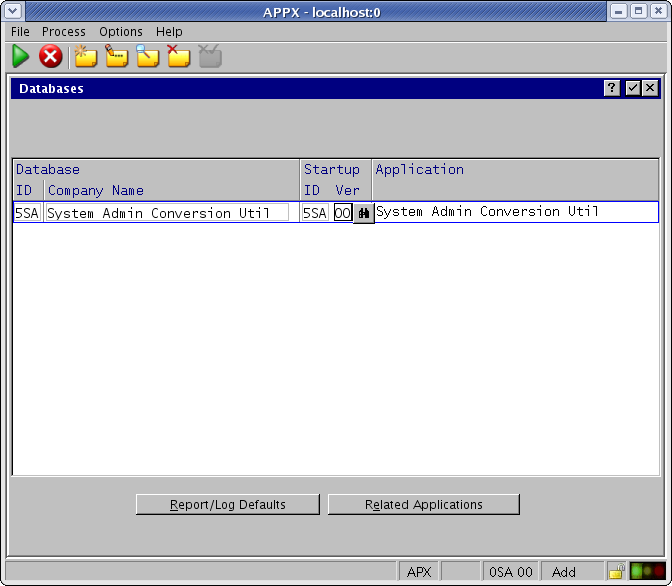 Run Database Management for the Upgrade Application and Database.
Run Database Management for the Upgrade Application and Database.
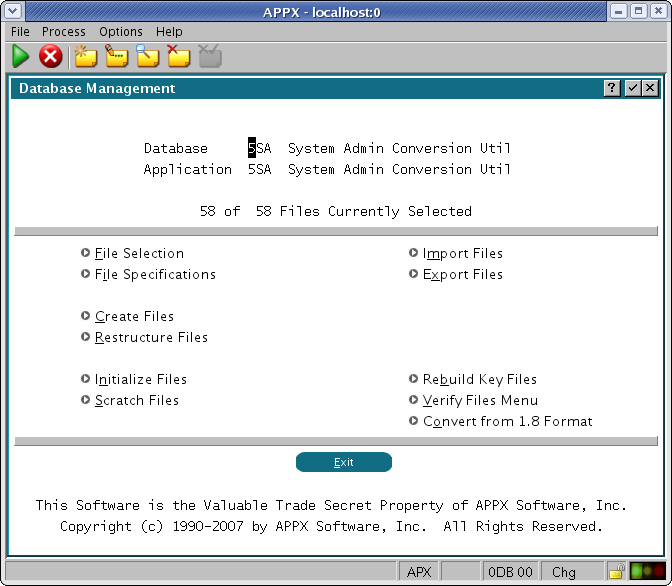 Run Create Files.
Run Create Files.
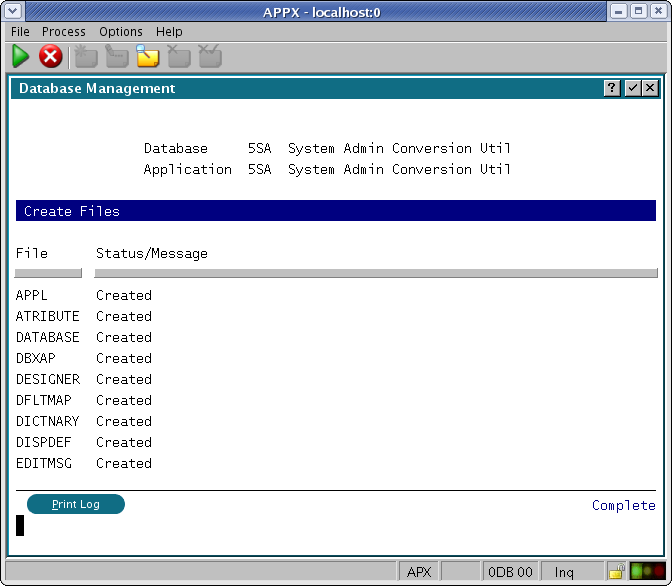
Run the Upgrade Application
After configuring the Upgrade Application, you must run the Upgrade Utility to convert your System Administration files. Run an Application (Option 1). 5SA.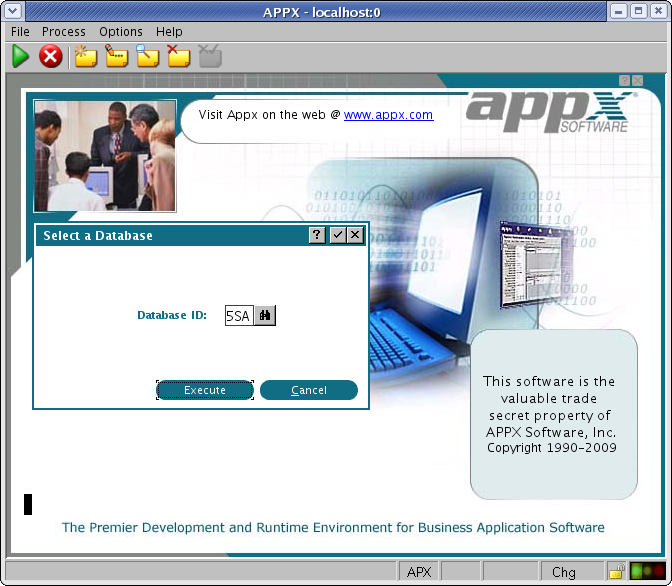 Click on the "Convert" button to run the conversion utility.
Click on the "Convert" button to run the conversion utility.
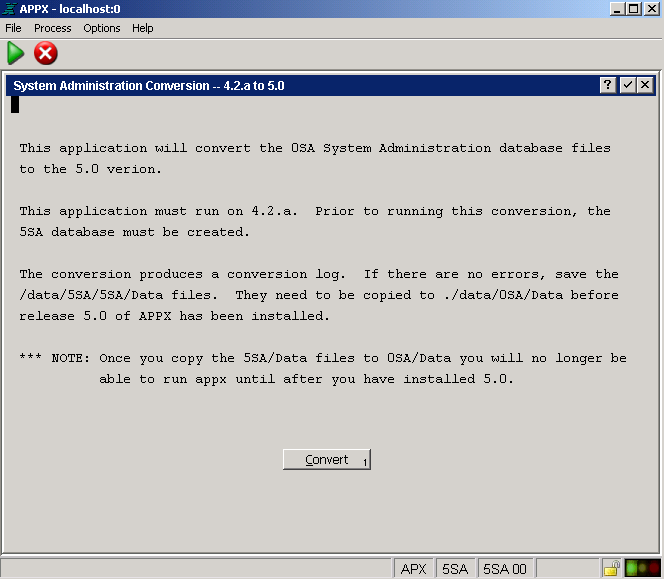 The conversion utility will create a log. Specify the appropriate disposition options to print the conversion log.
The conversion utility will create a log. Specify the appropriate disposition options to print the conversion log.
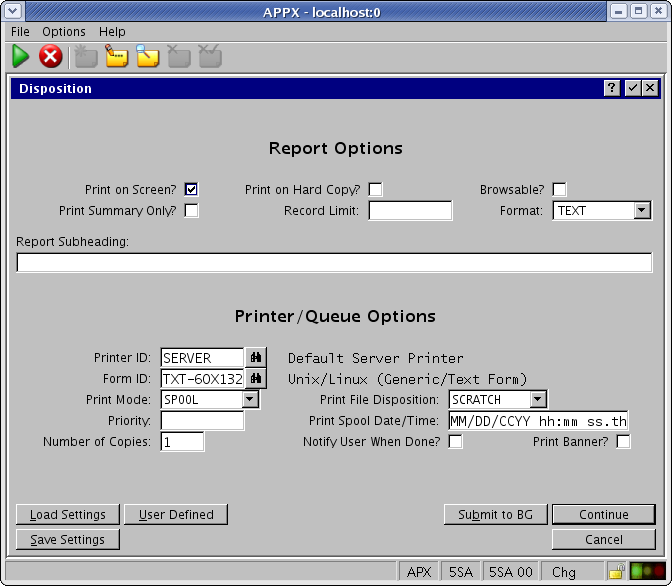 The conversion log will inform you of any problems that may have been encountered while running the conversion utility.
The conversion log will inform you of any problems that may have been encountered while running the conversion utility.
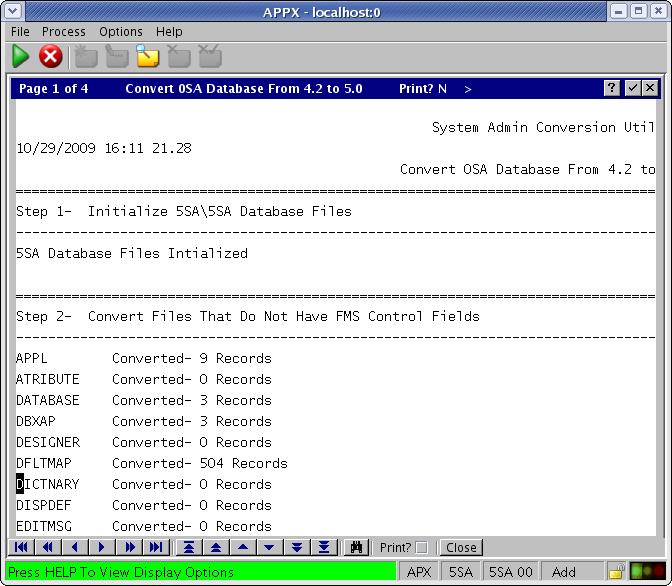
Install the Upgraded System Administration Files
Before you install the APPX Utility, you must first replace your old System Administration files with the new System Administration files that were created when you ran the upgrade utility to convert your System Administration files to the new APPX 5.0.0 structure. You can use a copy command similar to the example below to replace your old System Administration with the upgraded files. Be sure to edit the copy command to reference the directory where APPX is installed on your system if APPX is not installed in "C:\Appx" COPY C:\Appx\data\5SA\5SA\Data\ C:\Appx\data\0SA\Data\* If you are prompted to overwrite any files answer Yes or All. You should also remove the System Administration structure files. You can use a delete command similar to the example below to remove your System Administration structure files. Be sure to edit the command to reference the directory where APPX is installed on your system if APPX is not installed in "C:\Appx". DEL C:\Appx\data\0SA\Struct\* You are now ready to install Release 5 on top of your existing installation. Before installing APPX you should:- Stop the APPX Connection Manager service(s).
- Terminate (kill) any APPX sessions that are still active (there shouldn't be any if everyone has logged off)
- Terminate (kill) the APPX License Server session
Overview
Two different methods are provided to install APPX on Windows. There is a GUI installer and a Console Mode (character mode) installer. Most sites will use the GUI Installer, the character mode installer is intended for sites using Windows Core Server (Windows without a GUI). The same installer is used for both methods. The installer will automatically detect if it is being run as a command or from a GUI Desktop, although in some cases you may have to add "-c" to the command line to force the character installer. Regardless of which installation method is used, the result is the same. A typical APPX installation on a system where APPX has not been previously installed performs the following steps:- Creates the destination directory and installs APPX into it.
- Sets the appropriate permissions
- Runs APPX to allow you to complete the configuration
- Add APPX System Administrators to the APPX user file
- Configure and start the APPX Login Manager service
- Configure and start the APPX Audit Manager service
- Install the license key
GUI Installation on Windows
Log in to your system as an administrative user. Download and run the APPX GUI installer (appxsetup-windows.exe) from the APPX web site or the APPX ftp server. After a few moments, the APPX Setup Wizard should display the Welcome screen. Click on the "Next" button to continue. If you are presented with a Security Warning dialog, click on the "Run" button to continue with the installation.APPX will then be installed into the specified destination directory.
Character Mode Installation
If you are running Windows Core Server, you can run the Appx installer in character mode by appending "-c" to the command line. After a few moments, the Appx Setup Wizard should display the Welcome message. Press Enter to continue the installation.
C:\Appx>setup.exe -c
Unpacking JRE ...
Preparing JRE ...
Starting Installer ...
This will install Appx on your computer.
OK [o, Enter], Cancel [c]
Next, read and accept the License agreement. Press Enter as each page is displayed. Please read the following License Agreement. You must accept the terms of this agreement before continuing with the installation. Software License APPX Utility - Release 5.0.0 _ Important! _ Please read this carefully before you click on the Accept button. Definitions: "Software License Agreement (SLA)" shall mean this Software License document and the associated *License Key document collectively. [Enter] After the agreement has been displayed, enter 1 to accept the license agreement, or 2 to cancel the installation. .
.
.
For inquires regarding this agreement, please contact: APPX Software, Inc., 11363 San Jose Blvd., Suite 301, Jacksonville, Florida 32223, USA I accept the agreement Yes [1], No [2]
Choose the directory where APPX should be installed and the other installation options. Where should Appx be installed? [C:\APPX] Create a desktop icon? Yes [y, Enter], No [n] Create a Quick Launch icon? Yes [y, Enter], No [n]
Install a new APPX 5.x License Key
Double click the C:\Appx\AppxDesktopClient.exe file to start the Appx Desktop Client. Click on the 'Local' tab, enter the location of the APPX engine (the appx.exe file) and click the connect button. You should be presented with the following System Registration screen. Notice that the Effective Date field on this registration is blank. Starting with APPX 5.0.0, all License Keys include an Effective Date. You must install an updated License Key before you will be able to run APPX 5.x. Note that in Release 5 and higher you can copy your registration to the clipboard, and APPX will detect it when you choose "Typical Import" from the "Import Menu" below.Configure the new APPX Login Manager
APPX 5 includes the new APPX Login Manager service. This service replaces the Connection Manager (AppxdSvc) which was included with APPX releases prior to APPX 5.0.0. The old Connection Manager will not work with APPX 5 and higher, and should not be used. You should remove the services installed by appxdsvc using the '-remove' keyword: C:\Appx\tools>appxdsvc -remove -name=Appx8060 To configure and start the new APPX Login Manager service, log in as an administrative user and execute a command similar to the following: C:\Appx>CD servicesC:\Appx\services>appxLoginMgr.exe -install -name=appx8060 -displayName=appx8060 -port=8060 -engine=C:\Appx\appx.exe You should see the following messages: appx8060 Created
appx8060 Configured appx8060 Started
appx8060 will start automatically each time you boot your system After executing the above command, users should be able to use the APPX 5.0.0 Desktop Client to successfully login on port 8060. For additional information on managing APPX Login Services, please refer to the complete documentation.
Final Tasks
- Review your 'appx.env' file.
- Review your 'appx.env' file. Ensure any settings you still need are there. However, remove any obsolete settings. In particular, do not set APPX_42_EPS, this will cause system wide problems with Page Up/Down.
- Update the SYSDIR.
- System Administration (Option 3), System Setup (Option 1), System Administration File Management (Option 2), Update SYSDIR (Option 14).
- Create the new System Administration files ("System Administration/File Management/System Admin Files" on pull down menu).
-
- Upgrade Design Files
- Remove the Em, Dbg and Structure files for each of your applications. It is not necessary to do this to the applications supplied with Appx (0AD, 0LA, 0DB, 0SA, 1EX, DMO, etc)
- For example, your GL application's path for Em, Dbg and Struct files might look similar to: C:\Appx\data\01\DGL\Struct\* and C:\Appx\data\01\DGL\Em\* and C:\Appx\data\01\DGL\Dbg\*
- Run Create Files for each of your applications
- System Administration (Option 3), Database / Applications (Option 3), Design File Management (Option 5). Specify your Application and Version, Create Files (Option 3).
-
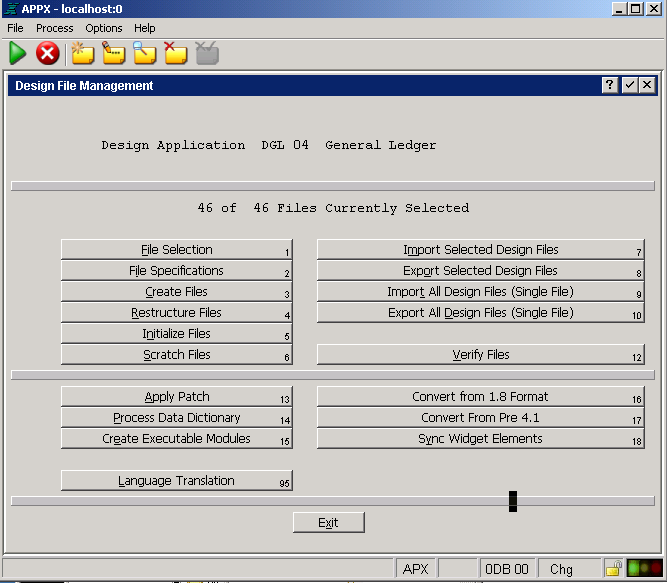
-
-
- Run 'Sync Widget Elements' for each of your applications from the Utilities Menu in Application Design. This is optional, as APPX will force you to do this the first time you go into an application after installing Release 5.0
-
-
- Run 'Load Initial Audit History' (Application Design > Utilities menu) for each of your applications. This is optional, as APPX will automatically build the history as you make changes to your application. For example, the first time you go into INPUTs, APPX will see that the audit history is missing and it will create it as it reads the input process records. Regardless of whether you run this, APPX will start keeping a detailed audit history of changes in applications from this point on. However, you should decide now whether to run this step now or not. If audit information already exists in the audit file when you run this step, it will duplicate the data
- Run 'Sync Design Elements' (Application Design > Utilities menu) for each of your applications.
- Remove the Em, Dbg and Structure files for each of your applications. It is not necessary to do this to the applications supplied with Appx (0AD, 0LA, 0DB, 0SA, 1EX, DMO, etc)
- If you are using Custom Fonts in your applications (i.e., bar codes, etc) and you have not already updated your Resources for the new method, follow these steps, otherwise they will not print.
- Install the new APPX Desktop Client for all users
- If you were using Appx/ODBC, you must install the new version. The old version is not compatible with Release 5 and will not work. See this page for installation instructions.
- Configure new features as desired
Comments:
Read what other users have said about this page or add your own comments.-- SteveFrizzell - 2 Nov 2009
| I | Attachment | History | Action | Size | Date | Who | Comment |
|---|---|---|---|---|---|---|---|
| |
DestinationDirectory_win.PNG | r1 | manage | 24.1 K | 2011-01-04 - 16:44 | UnknownUser | |
| |
Fnished_win.PNG | r1 | manage | 83.2 K | 2011-01-04 - 16:33 | UnknownUser | |
| |
InstallingFiles_win.PNG | r1 | manage | 21.3 K | 2011-01-04 - 16:33 | UnknownUser | |
| |
Instructions_win.PNG | r1 | manage | 29.2 K | 2011-01-04 - 16:32 | UnknownUser | |
| |
License_win.PNG | r1 | manage | 32.3 K | 2011-01-04 - 17:50 | UnknownUser | |
| |
License_win_before.PNG | r1 | manage | 32.3 K | 2011-01-04 - 18:41 | UnknownUser | |
| |
Welcome_win.PNG | r1 | manage | 83.1 K | 2011-01-04 - 16:29 | UnknownUser | |
| |
create-design-files.png | r1 | manage | 40.9 K | 2010-09-09 - 20:30 | JoeOrtagus |
Ideas, requests, problems regarding TWiki? Send feedback

